Essential Remote Work Tools for Software Engineers
Remote work has reshaped software development. But it’s not without challenges like time zones, project management, and security. This guide covers 10 tools that solve these problems and help teams stay productive:
- Slack: For team communication with integrations and real-time alerts.
- Zoom: High-quality video meetings with screen sharing and breakout rooms.
- VS Code Remote: Seamless remote development with SSH and containers.
- GitHub Codespaces: Cloud-based coding environments, no setup needed.
- GitHub Enterprise: Secure, scalable code management for large teams.
- Tuple: Purpose-built for remote pair programming with low latency.
- Rookout: Live debugging without disrupting production environments.
- Gitpod: Browser-based coding with pre-configured environments.
- Swimm: Keeps code documentation accurate and synced with updates.
- 1Password Secrets Automation: Securely manages API keys and credentials.
Quick Comparison
| Tool | Purpose | Key Features |
|---|---|---|
| Slack | Communication | Channels, tool integrations, alerts |
| Zoom | Video meetings | Screen sharing, recording, breakout rooms |
| VS Code Remote | Remote development | SSH, containers, debugging |
| GitHub Codespaces | Cloud development | Browser-based, resource scaling |
| GitHub Enterprise | Code management | Security, CI/CD, team policies |
| Tuple | Pair programming | Low latency, annotations, screen sharing |
| Rookout | Debugging | Non-breaking breakpoints, observability |
| Gitpod | Online development | VS Code integration, terminal access |
| Swimm | Documentation | Auto-sync, IDE integration, playlists |
| 1Password Secrets | Security | Credential management, CI/CD integration |
These tools enhance productivity, collaboration, and security for remote teams. Start with those that fit your team’s specific needs.
Top 5 Must-Have Productivity Tools for Remote Software Developers in 2024 #softwaredevelopment
1. Slack for Team Communication
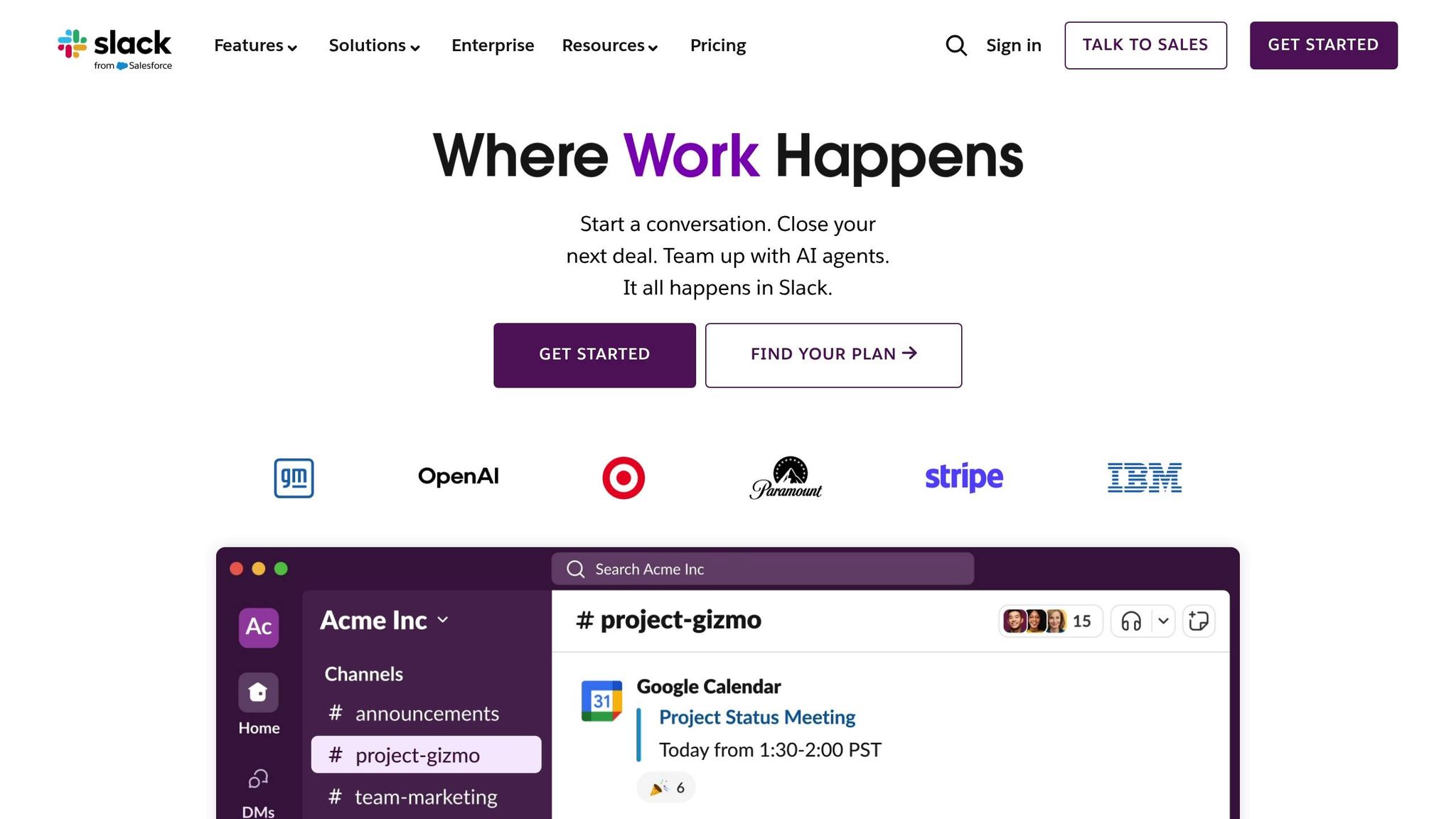
Slack has become a go-to platform for remote teams, with 53% of developers relying on it as their main communication tool [1]. Teams using Slack have reported delivering 24% more features on time and reducing time to market by 23% [2].
Its ability to integrate with tools like GitHub, JIRA, and CI/CD pipelines makes it a powerful asset for streamlining workflows. For example, Aaron Suggs, operations engineering manager at Kickstarter, introduced an automated deploy process via Slack, which helps reduce interruptions - a critical factor when developers need to stay focused [3].
Top Features for Development Teams:
- Organized Channels: Set up channels for specific projects, teams, or tasks like
#backend-team,#deployment-alerts, or#code-reviewsto keep discussions focused. - Tool Integrations: Link Slack with tools like GitHub and PagerDuty to centralize notifications and simplify workflows.
- Code Discussions: Use threads for code reviews and technical debates, keeping conversations clear and reducing the need to switch contexts.
- Incident Management: Handle real-time alerts and troubleshooting in dedicated channels, cutting mean time to resolution from 15–20 minutes to under 5 minutes [2].
"The whole point is to be simple and easy to understand and get into for new people or people on a project - they've got the whole history right there."
Jeremy Mack, Director of Engineering at Postlight, highlights how Slack helps teams maintain institutional knowledge [3].
| Feature | Impact on Workflow |
|---|---|
| Automated Alerts | 21% less time spent identifying and fixing bugs [2] |
| Integrated Workflows | 27% reduction in time spent on testing and iteration [2] |
| Real-time Collaboration | 47% boost in overall productivity [4] |
| AI-powered Features | Saves 97 minutes per user every week [4] |
2. Zoom for Video Meetings
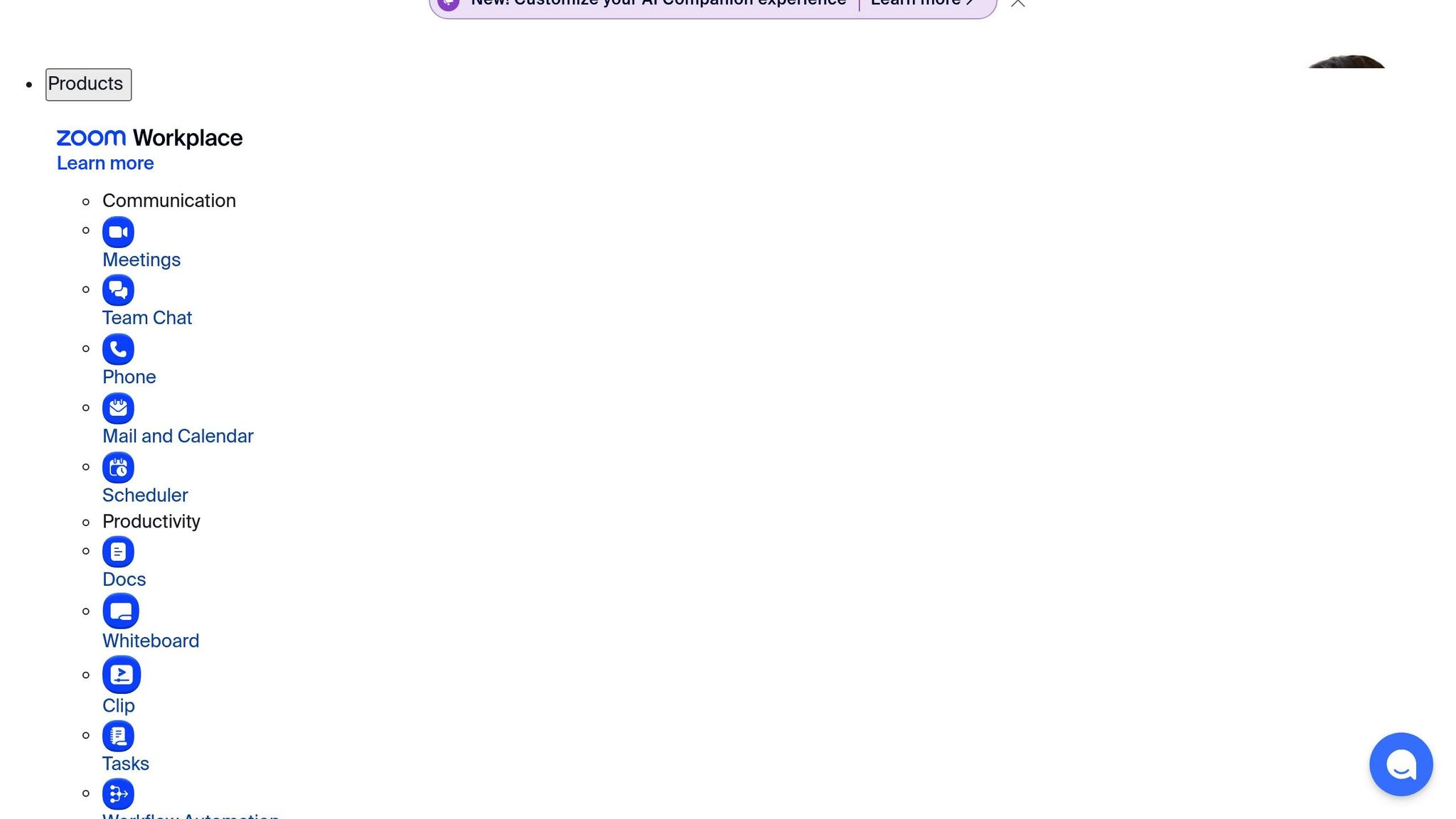
Zoom has become a go-to tool for remote software engineering teams, offering high-quality video conferencing that makes collaboration easier and more effective.
Key Collaboration Features:
With screenshare, teams can review diagrams, screenshots, or code in real time, ensuring everyone is aligned. As Vineel Shah, Senior Engineering Manager at Walmart Global Technology, explains:
"Having a specific agenda is even more important for a technical meeting than a non-technical one, because a meandering technical discussion can be infinite and leave the important problems unsolved." [5]
Tips for Productive Technical Meetings:
Setting a clear agenda is crucial for keeping engineering discussions on track. Avoiding distractions during technical deep dives is equally important. These practices work hand-in-hand with other remote tools to improve collaboration.
Best Practices for Engineering Teams:
- Use a text editor during meetings to capture technical decisions and actions
- Share code or IDE screens during live coding sessions for better alignment
- Leverage breakout rooms for focused discussions on specific challenges
- Record architecture review sessions for future reference
Technical Setup Recommendations:
- A quality headset for clear audio during discussions
- Ethernet connection to ensure stable screen sharing
- A dedicated workspace with proper lighting for better focus during sessions
3. Visual Studio Code Remote for Development
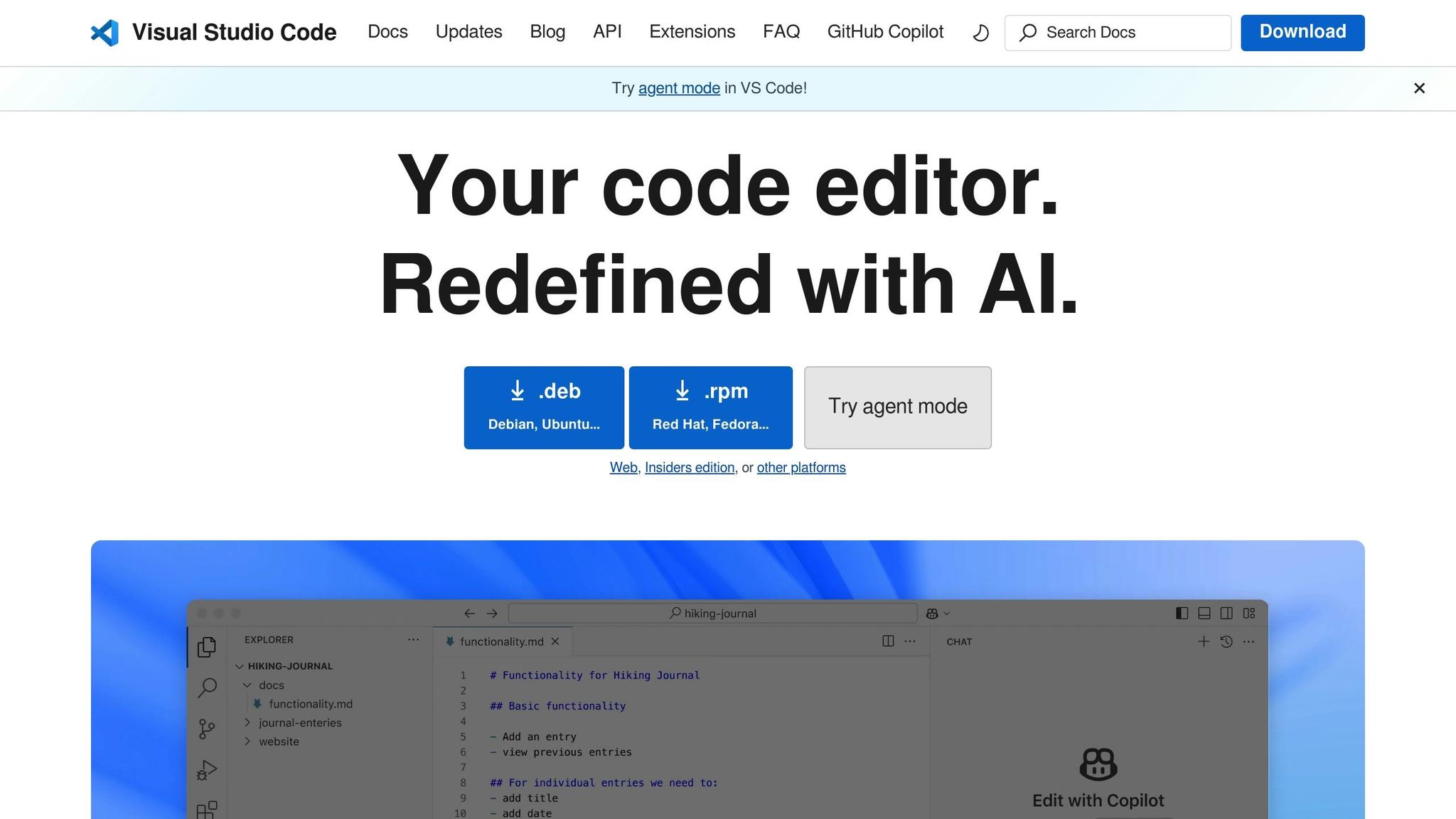
When it comes to remote development, having the right tools can make all the difference. Visual Studio Code Remote Development lets you work seamlessly with containers, remote machines, or Windows Subsystem for Linux (WSL), turning them into fully functional development environments.
Key Features for Remote Development
The Remote Development extension pack provides tools specifically designed for remote work:
- Remote-SSH: Connect to any server with SSH enabled.
- Dev Containers: Simplify container-based development.
- WSL Integration: Work directly within the Windows Subsystem for Linux.
- Remote Tunnels: Securely connect to remote environments.
A Better Development Experience
With VS Code Remote, you get features like IntelliSense, code navigation, and debugging - all without needing the source code on your local machine [6]. It’s like having your entire development stack available anywhere.
System Requirements and Security
To use VS Code Remote effectively, you’ll need a stable internet connection and a computer with moderate system resources. For security:
- Opt for key-based SSH authentication.
- Enable the
Remote.SSHserver socket setting. - Configure host-specific security options to enhance protection.
Real-World Benefits
Here’s how VS Code Remote can improve your workflow:
| Benefit | Description |
|---|---|
| Environment Consistency | Keeps development setups uniform across the team. |
| OS Flexibility | Lets you develop on the same OS as your deployment environment. |
| Resource Access | Use remote hardware and computing resources without local limitations. |
| Multi-Location Access | Switch between machines while maintaining the same environment setup. |
Tips for Better Performance
- Use VS Code’s port forwarding to access remote services easily.
- Edit single files with SSHFS for quicker access.
- Handle large file transfers with
rsync. - Customize host-specific settings via the Preferences: Open Remote Settings command.
With these tools and tips, VS Code Remote makes it easy to stay productive, regardless of where you’re working. It ensures consistency across environments and gives developers the flexibility they need to tackle complex projects from anywhere.
4. GitHub Codespaces for Cloud Development
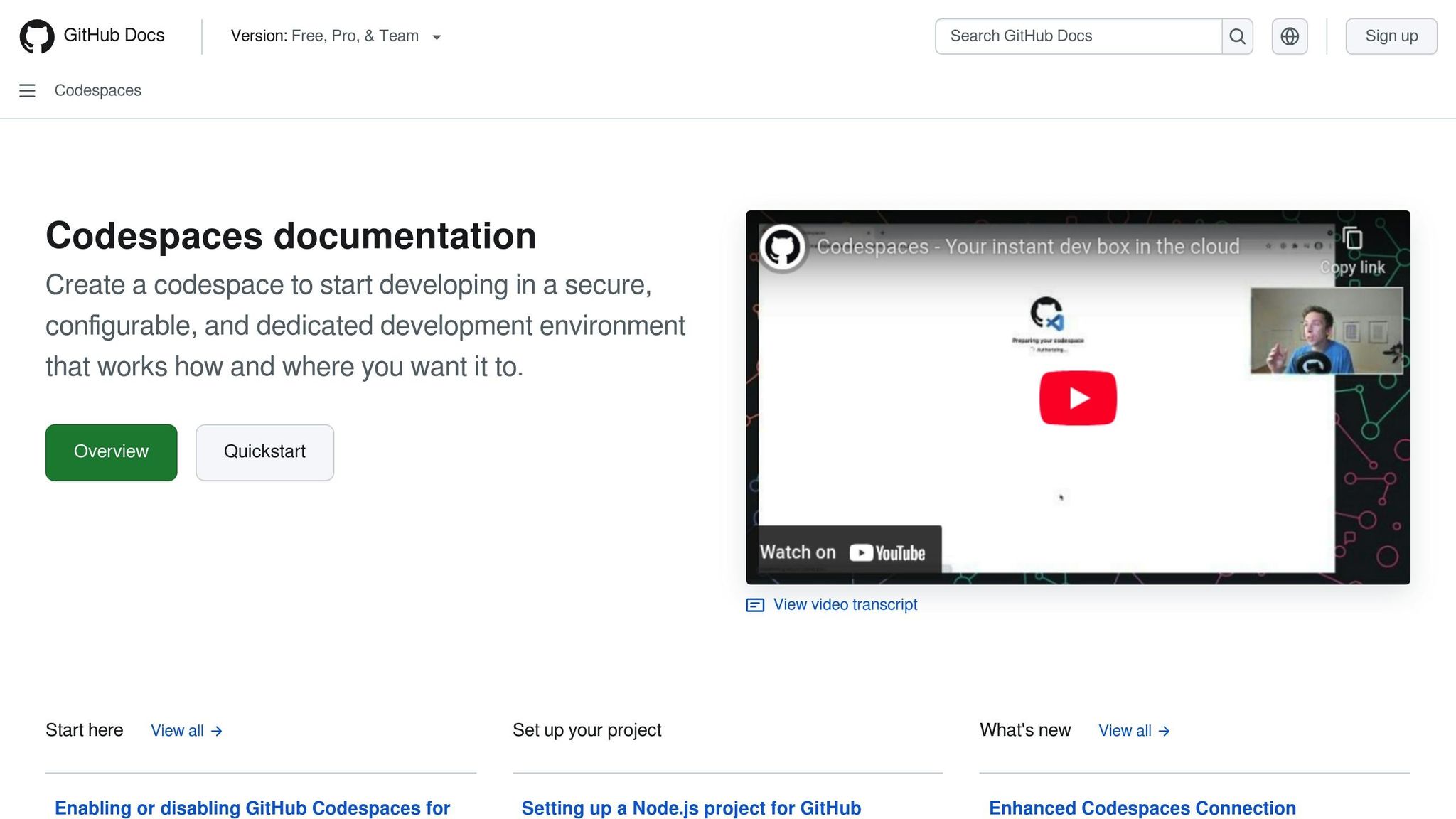
GitHub Codespaces provides a browser-based development environment that's easy to set up and fully customizable. It removes the hassle of configuring local development setups.
Simplifying Cloud Development
Codespaces operates on Ubuntu-based Docker containers hosted on virtual machines. These environments can handle resource-heavy projects with options like:
- Up to 32 processor cores
- 64 GB of RAM
- 128 GB of storage
Flexible Customization Options
Codespaces offers various ways to tailor your development environment:
| Method | Purpose | Advantages |
|---|---|---|
| Dev Container Configs | Define environment settings | Ensures uniform environments |
| Dotfiles Repository | Personalize preferences | Keeps workflows familiar |
| Settings Sync | Sync editor configurations | Matches your local VS Code setup |
How to Start Using Codespaces
Getting started is straightforward:
- Go to your GitHub repository.
- Click the "Code" button.
- Select "Open with Codespaces".
- Choose your desired compute settings.
- Start coding almost instantly.
Practical Use Cases
Teams working on mobile apps often use Codespaces to simplify backend setup. By running the backend in separate Codespaces, developers can use the generated URL as the backend endpoint for their mobile apps [7]. This eliminates the need for local backend setups and ensures consistent testing environments.
Resource Allocation
Personal GitHub accounts come with 60 free hours of Codespaces usage every month [7].
Seamless Integrations
Codespaces integrates effortlessly with:
- Visual Studio Code for a smooth editing experience
- GitHub CLI for command-line workflows
- Standard Git workflows to keep everything in sync
Tips for Better Performance
To get the most out of Codespaces:
- Set up dev container configurations for consistent environments.
- Use Settings Sync to replicate your local editor preferences.
- Scale compute resources to fit your project's demands.
- Make use of prebuilt container images to save time.
These tips can help you optimize your workflow and fully utilize Codespaces as part of your remote development toolkit.
5. GitHub Enterprise for Code Management
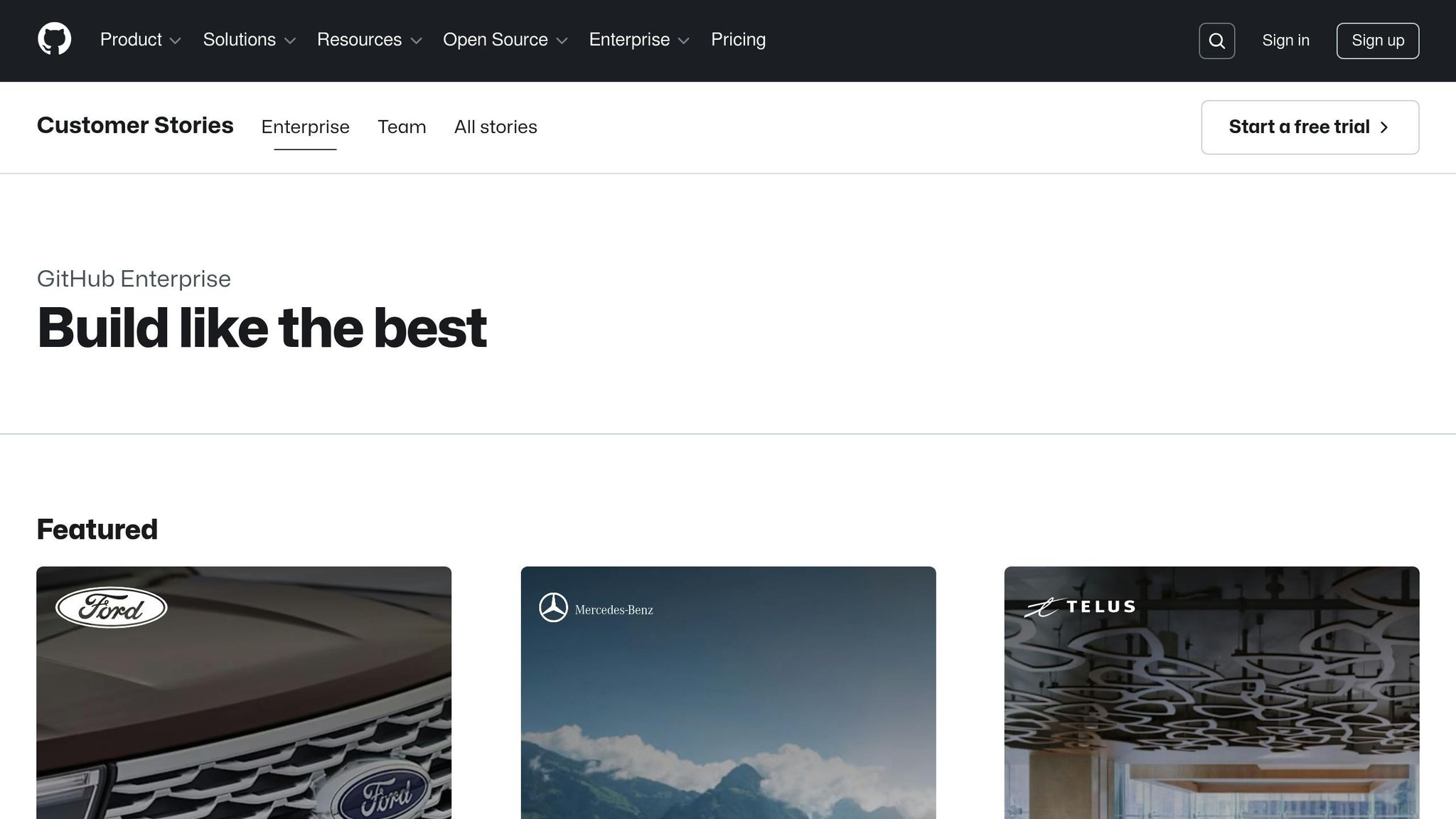
GitHub Enterprise is designed to provide enhanced security and control for large remote teams, building on the cloud development and code management tools we've already covered. Trusted by 90% of Fortune 100 companies [8], it centralizes collaboration and enforces strict security measures, making it a go-to platform for enterprise-level software development.
Built-In Security Features
GitHub Enterprise integrates key security tools directly into the development process:
| Security Feature | Purpose | Benefit |
|---|---|---|
| SAML SSO | Secure application access | Simplifies authentication |
| Secret Protection | Prevents credential leaks | Adds proactive safeguards |
| Dependabot | Manages dependencies | Automates updates |
| Code Security | Detects vulnerabilities | Identifies threats early |
These features work seamlessly within the workflow, helping teams focus on coding without compromising security.
Boosting Productivity
GitHub Enterprise isn't just about security - it also saves time and streamlines processes:
- Developers save 45 minutes per day [9].
- Onboarding time is cut by 40% [9].
- CI/CD workflows become more efficient.
"With GitHub Actions, we streamlined our CI/CD workflows, reducing pipelines from 1,000 lines to just 100. This simplicity has enhanced developer happiness and productivity." - Sanjito Kurniawan, Senior Platform Engineer [8]
Tips for Managing Remote Teams
To make the most of GitHub Enterprise for remote collaboration, try these approaches:
- Organizational Repositories: Use organization-owned repositories to ensure consistent access control and maintain ownership.
- Team Structure: Set up nested teams to reflect your company hierarchy and manage repository access more effectively.
- Enterprise Policies: Apply company-wide policies to enforce consistent security practices across all teams.
Deployment Options
GitHub Enterprise offers two deployment models to suit different organizational needs:
| Model | Description | Best For |
|---|---|---|
| Enterprise Cloud | Cloud-hosted solution | Teams looking for a quick setup |
| Enterprise Server | Self-hosted deployment | Organizations needing full control |
Choosing the right deployment model enhances both security and collaboration for remote teams.
"It's easy to add tools but never check the results. By pulling everything into one place, GitHub Advanced Security makes it easy to benefit from all our different tools." - Phil Wright-Christie, Lead DevOps Engineer [8]
Centralized Account Management
GitHub Enterprise simplifies account management by centralizing billing, enforcing security settings, syncing teams with identity providers, and logging audits. This setup ensures remote development teams stay efficient while maintaining strong oversight and security.
sbb-itb-7cee4ec
6. Tuple for Pair Programming
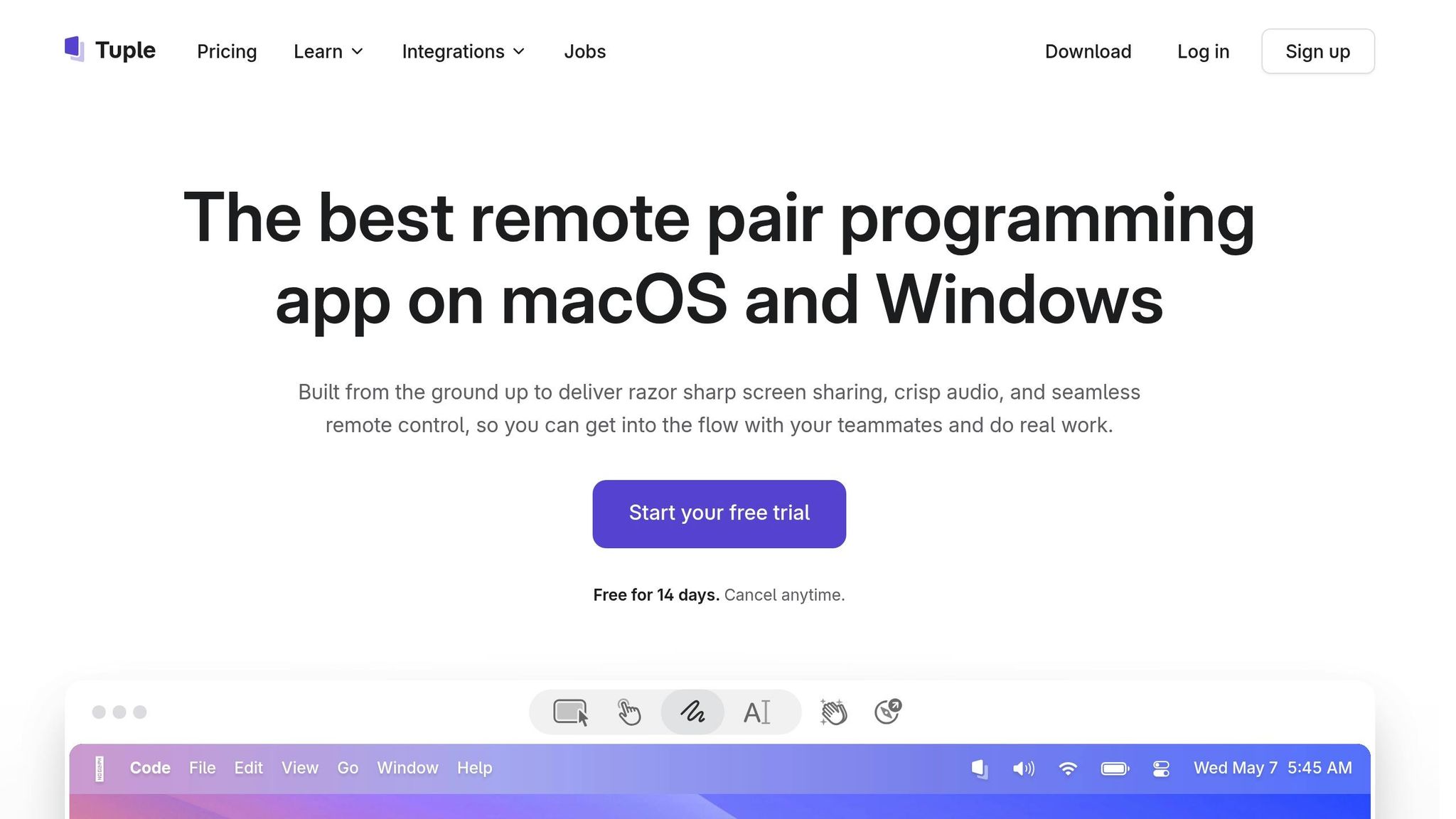
Tuple is a remote pair programming tool designed specifically for software engineers. It’s built to make remote collaboration smooth and efficient.
High-Performance Architecture
Tuple's C++ foundation ensures top-notch performance:
| Feature | Specification | Why It Matters |
|---|---|---|
| Screen Resolution | Up to 5K | Clear visibility for your code |
| Resource Usage | Low CPU usage | Keeps your system running fast |
| Security | End-to-end encryption | Keeps your work secure |
| Platform Support | macOS and Windows | Works across popular platforms |
Collaboration Features Built for Developers
Tuple comes with features designed to make remote pair programming easier and more effective:
- App Veil: Automatically hides sensitive apps and notifications during screen sharing.
- One-Click Driver Switching: Quickly switch control between collaborators without interruptions.
- Smart Keyboard Shortcuts: Keeps your workflow smooth and efficient.
- Screen Annotations: Highlight and discuss code directly on the screen.
These tools are crafted to help teams communicate and collaborate better, no matter where they are.
How Tuple Makes a Difference
Big names in tech are already using Tuple to improve their workflows. For example, Shopify has adopted it as their go-to tool for remote pair programming. Farhan Thawar, Shopify's VP of Engineering, shared:
"Tuple has become our default tool for remote pairing at Shopify. The teams love it." [10]
Andrés Taylor, a developer at PlanetScale, also praised Tuple:
"It's the best tool for remote pair programming. Latency is important, keyboard binding all just works. It feels like you're working on a shared computer." [10]
Automating Your Workflow
Tuple helps automate repetitive tasks and improve efficiency by allowing you to:
- Connect to call events.
- Run custom scripts.
- Tailor the pairing experience.
- Simplify routine actions.
Tips for Better Remote Pair Programming
- Focus on Screen Quality: Use Tuple’s high-resolution sharing for clear code visibility.
- Leverage Annotations: Highlight code and diagrams to explain your ideas better.
- Customize Shortcuts: Adjust keyboard shortcuts to align with your team’s needs.
- Use Privacy Features: Enable App Veil to keep private notifications hidden during sessions.
Independent iOS engineer Mikaela Caron shared her experience:
"Tuple allows me to thrive as an independent developer, easily chatting with freelance clients, mentoring others, and collaborating on open-source projects." [10]
7. Rookout for Remote Debugging
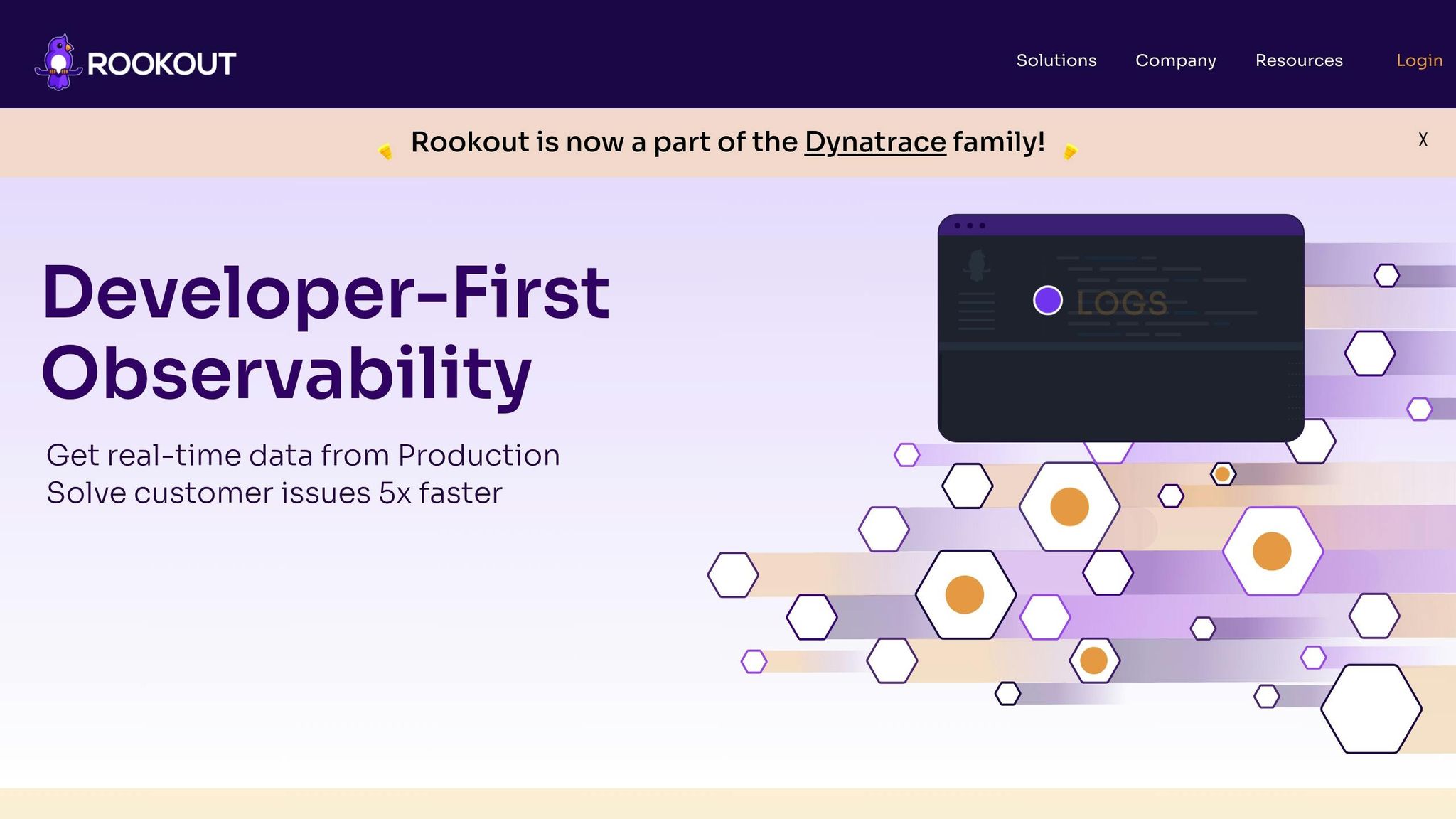
Rookout simplifies remote debugging by offering live, uninterrupted debugging capabilities. It brings the convenience of local debugging to remote environments, making it a go-to tool for distributed teams.
Real-Time Debugging Features
| Feature | Capability | Benefit |
|---|---|---|
| Non-Breaking Breakpoints | Collect live data without stopping the app | Keeps production stable |
| Virtual Log Lines | Add logs dynamically | Cuts down deployment cycles |
| Code-Level Observability | Combines logs, traces, and metrics | Improves debugging visibility |
| Multi-Environment Support | Works across dev, staging, and production | Debugs seamlessly in any setup |
Advanced Debugging Capabilities
Rookout supports multiple programming languages, including Java, .Net, Node.js, Python, Ruby, and Golang. It works across diverse environments such as cloud-native systems, on-premises setups, virtual machines, containers, and serverless platforms - all through one unified platform.
Performance and Security
Rookout ensures high performance while adhering to rigorous security standards:
- Availability: 99.5% uptime
- Certifications: SOC 2 Type 2, GDPR, CCPA, HIPAA, ISO 27001
- Data Protection: Includes data redaction and on-premises options
- Support: 24/7 technical assistance for enterprise users
Real-World Impact
Aidoc, a healthcare AI company, saw major improvements in debugging efficiency. Guy Reiner, VP R&D at Aidoc, explained:
"Rookout makes it possible to find bugs without spending hours on log-collection and trying to simulate the unique real-world environment of a particular hospital network" [12]
Integration Capabilities
Rookout integrates smoothly with modern development tools, enhancing the debugging process:
- Observability Tools: Compatible with OpenTracing and OpenTelemetry
- Performance Analysis: Offers real-time profiling with flame graphs
- Data Pipelines: Sends live debug data to collaboration and observability platforms
- Metrics Generation: Provides on-demand performance insights
These integrations ensure that live debugging data flows directly into your existing tools, streamlining workflows.
Practical Applications
Rookout significantly boosts development efficiency. Liran Haimovitch, Rookout CTO and co-founder, highlighted:
"Being able to remotely debug live Electron apps means developers can find and fix bugs quickly, freeing up R&D resources to work on creating new features instead." [12]
Research shows that teams using Rookout resolve customer issues up to five times faster [11].
8. Gitpod for Online Development
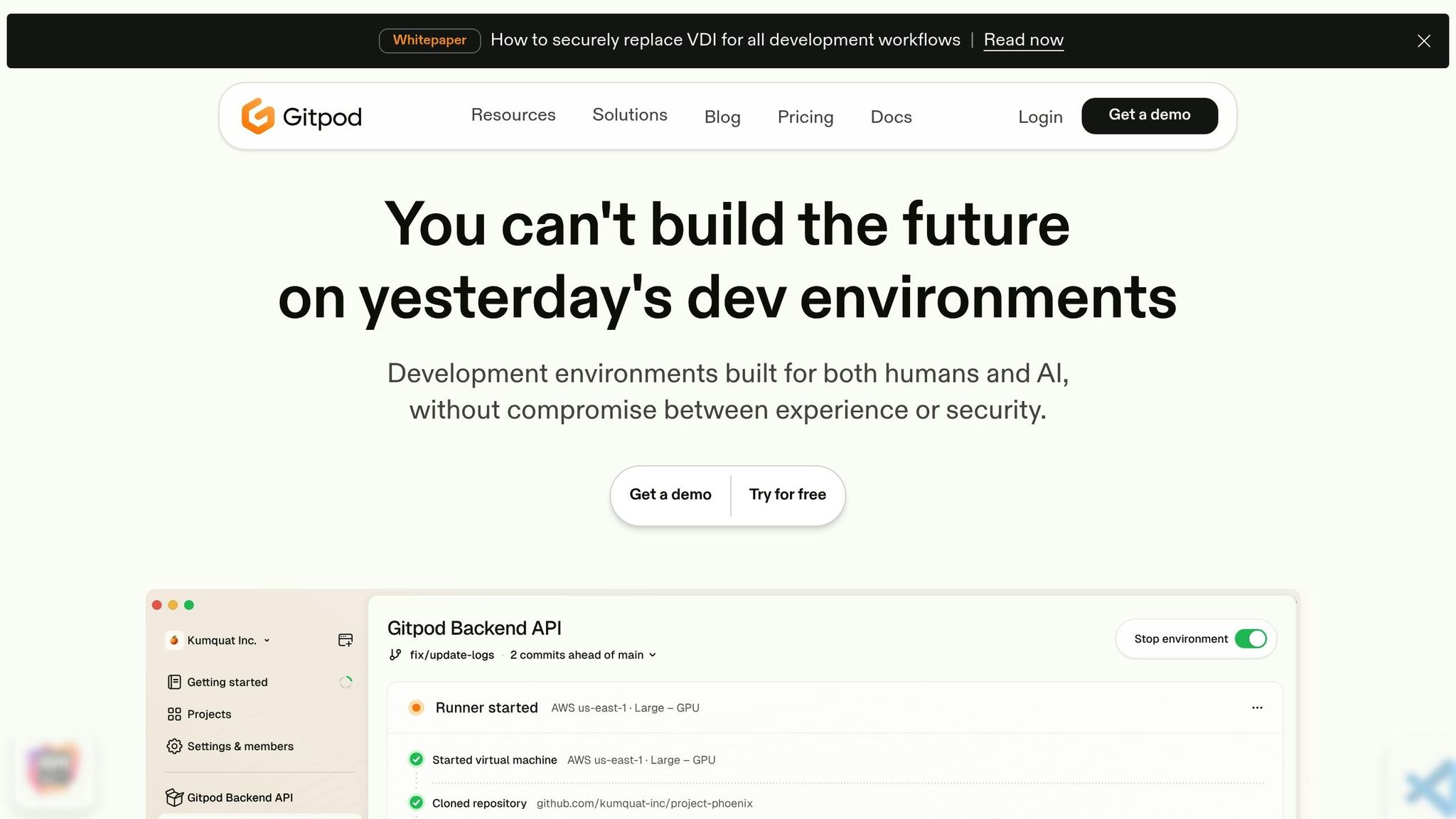
Gitpod takes remote development to the next level by providing browser-based workspaces, eliminating the hassle of local setup. This cloud-based platform lets software engineers dive straight into coding with fully configured environments.
Browser-Based Development Features
| Feature | Capability | Benefit |
|---|---|---|
| VS Code Integration | Full VS Code experience in the browser | Familiar tools, no learning curve |
| Multi-Editor Support | Works with VS Code and JetBrains | Freedom to choose your editor |
| Git Platform Integration | Compatible with GitHub, GitLab, and Bitbucket | Easy access to repositories |
| Terminal Access | Command line directly in the browser | Full control over development |
| Port Management | Auto port forwarding and previews | Simplifies application testing |
With these features, Gitpod ensures a smooth development experience right from your browser.
Workspace Configuration
Customizing your workspace is simple with Gitpod's automated setup. Here's an example configuration:
tasks:
- init: yarn install
command: yarn start
ports:
- port: 3000
onOpen: open-preview
This setup ensures your development environment is ready to go without any manual intervention.
Collaboration Capabilities
Gitpod makes teamwork easier with real-time collaboration tools. Developers can instantly share their workspaces, enabling pair programming and streamlined code reviews - perfect for distributed teams.
Performance Impact
Gitpod can increase developer productivity by 15% annually [13]. This boost comes from eliminating delays caused by local setups and ensuring consistent environments for every project.
Environment Management
Here are some key commands to manage your Gitpod environment:
- Environment Validation: Use
gp validateto check your configuration. - Quick Setup: Start new projects with
gp init. - Port Management: Track active ports with
gp ports. - Task Automation: Handle tasks easily using
gp tasks.
These tools help maintain a smooth and efficient workflow.
Security and Infrastructure
Gitpod operates on a zero-trust model, offering secure, automated environments that can run in your cloud account (VPC), on local machines, or on-premises. As Gitpod highlights in its documentation:
"You can't build the future on yesterday's dev environments" [13]
This approach ensures modern workflows with minimal friction for developers.
Integration Workflow
To create a workspace with just one click, install the Gitpod browser extension and prefix any repository URL with gitpod.io/#. This integration works with major Git platforms and provides consistent environments for all team members.
9. Swimm for Code Documentation
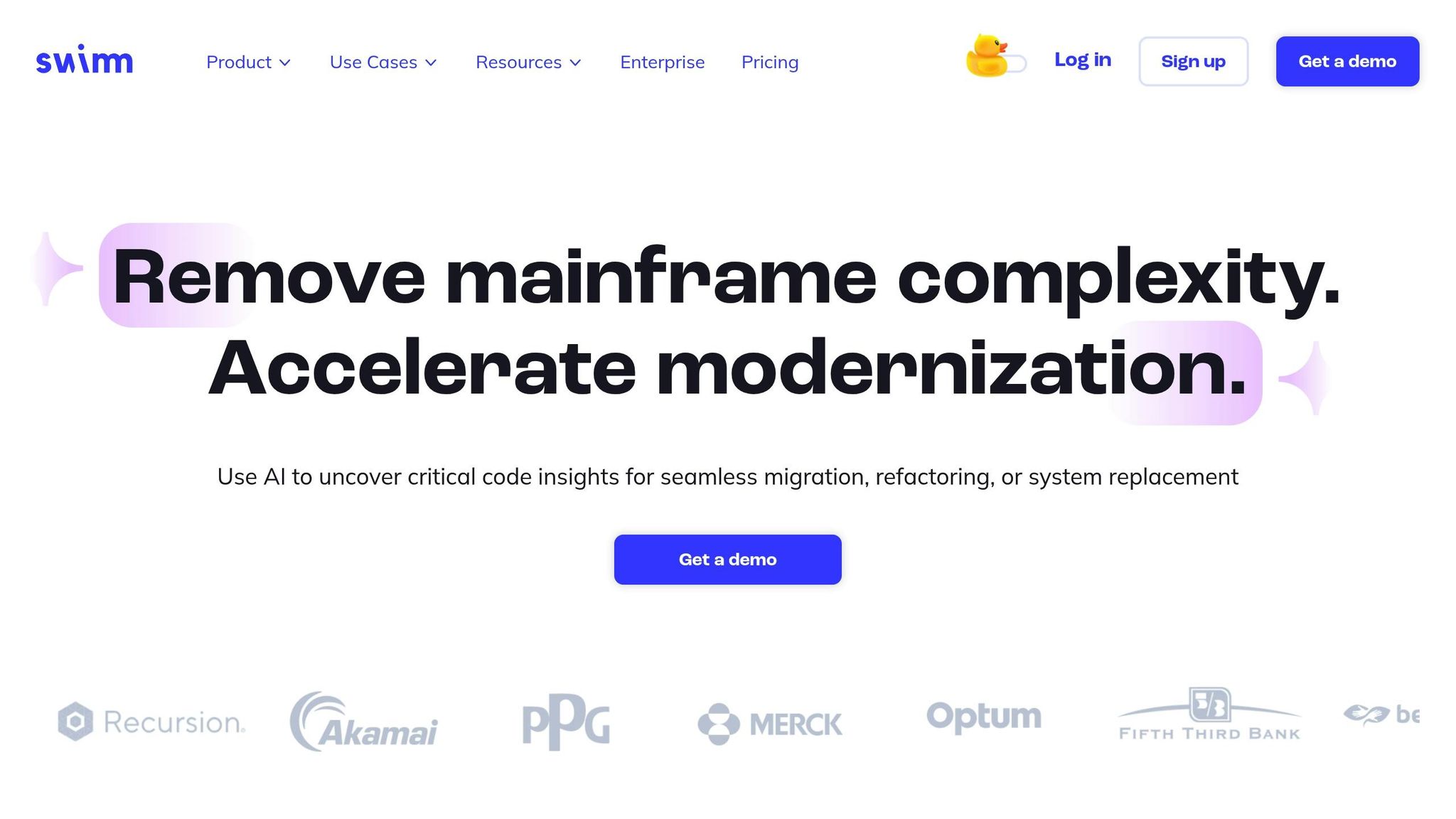
Swimm brings a modern approach to code documentation, designed specifically for remote teams. Its code-coupled system ensures documentation stays accurate and aligned with the latest code changes, solving a common challenge in remote development workflows.
Key Features of Swimm
| Feature | Functionality | Benefit |
|---|---|---|
| Code-Coupled Editor | Syncs automatically with code updates | Prevents outdated documentation |
| IDE Integration | Access docs directly in the editor | Saves time searching for information |
| Mermaid Support | Generates diagrams from code | Simplifies visual documentation |
| Auto-Verify | Continuously validates documentation | Maintains accuracy without manual effort |
| Knowledge Sharing | Links documentation to authors | Encourages team collaboration |
These tools make Swimm an essential asset for teams needing documentation that evolves with their codebase.
Automated Documentation Tracking
Swimm has processed over 300 million lines of code and verified documentation more than 1 billion times [14]. Its system tracks code changes automatically, notifying developers when documentation updates are required.
Seamless IDE Integration
With Swimm, developers can view documentation directly within their coding environment. This feature is particularly useful for remote teams working across time zones, reducing the time spent searching for relevant documentation [14].
Enhancing Knowledge Sharing
Ryan McKenna, Staff Engineer at RVO Health, shared his experience with Swimm:
"Swimm is a tool that we don't know how we ever lived without. Accessible information improved productivity and made transferring knowledge between engineers frictionless." [14]
Documentation Playlists
The Playlist feature helps onboard new team members by creating guided paths through the codebase. This makes it easier for remote engineers to familiarize themselves with complex projects.
Verification and Updates
Swimm's automatic verification system ensures documentation stays up-to-date, achieving an impressive 80% acceptance rate [14].
Business Benefits
For remote teams, where delays in communication can slow down progress, Swimm’s streamlined documentation process delivers measurable results. Some organizations have reported potential returns of up to 350% within the first year [14].
Dynamic Mermaid Diagrams
Swimm also keeps visual documentation current by automatically updating system diagrams. A.J. Williams, Associate Director of Engineering at Recursion, praised the platform:
"Swimm is basically the first true innovation in the last 10 years in the knowledge management and documentation space." [14]
Swimm’s focus on keeping documentation accurate and accessible makes it a powerful addition to remote work tools, enhancing team collaboration and efficiency.
10. 1Password Secrets Automation for Security

1Password Secrets Automation is designed to safeguard critical information such as API keys, database credentials, and infrastructure secrets. In remote work setups, securely managing development assets is more important than ever.
Automated Secrets Management
This tool secures sensitive data within code repositories, reducing the risk of accidental exposure. Instead of hard-coded credentials, it uses encrypted vaults that act as a centralized, secure reference point for secrets [15].
Integration Capabilities
1Password Secrets Automation integrates seamlessly with a variety of tools and platforms:
| Integration Type | Features | Benefits |
|---|---|---|
| CI/CD | Works with GitHub Actions, CircleCI, and Jenkins | Simplifies deployment workflows |
| IDEs & CLI | Offers IDE extensions and CLI access | Adds security directly into development tools |
| Infrastructure | Supports Kubernetes, Terraform, and Ansible | Automates secret management for infrastructure |
| Programming | Provides SDKs for Python, JavaScript, and Go | Enables smooth integration into codebases |
Deployment Options
- Service Accounts: Perfect for shared environments, offering built-in CLI support without requiring extra infrastructure. This option is included with a standard 1Password subscription.
- Connect Servers: A self-hosted solution that supports unlimited API requests, delivers lower latency, and scales efficiently.
Security Features
1Password Secrets Automation includes advanced features to enhance security:
| Feature | Functionality | Benefit |
|---|---|---|
| Detection & Rotation | Identifies and rotates secrets | Minimizes exposure risks |
| Access Control | Manages permissions at a granular level | Ensures least privilege access |
| Environment Config | Secures shared configurations | Improves team collaboration |
These features make it a reliable choice for businesses aiming to maintain high-security standards.
"With the addition of Secrets Automation, 1Password can now protect all of your company's secrets in one place." [16]
Developer Workflow Integration
1Password Secrets Automation fits smoothly into existing development workflows with features such as:
- Private REST API access through the 1Password Connect server
- Open-source SDKs for various programming languages
- Direct integration with terminals and IDEs
- Automated secret management for cloud-based infrastructure
Conclusion
Using remote work tools can significantly enhance productivity and collaboration in software engineering. With the right integration approach, these tools can evolve from standalone solutions into a streamlined workflow that supports distributed teams effectively.
Best Practices for Implementation
-
Establish Communication Guidelines
Create clear protocols for both synchronous and asynchronous communication to avoid confusion and ensure everyone stays connected. -
Prepare Development Environments
Configure cloud-based environments that integrate smoothly with version control systems and communication platforms. -
Strengthen Security Measures
Enforce security protocols across all tools, prioritizing data protection and controlled access.
These steps help create a strong framework for improving team efficiency and output.
"Investing in the right tools for remote work is about empowering your team with the resources they need to excel." - The Rippling Team [17]
Measuring Success
Full Scale's approach to tool integration highlights the benefits, showing better sprint completion rates and a 27% boost in overall productivity [17].
Integration Strategy
Prioritize smooth integration between tools to minimize workflow disruptions and maintain high performance. Regularly reviewing tools and gathering team feedback ensures the solutions stay relevant and effective as team requirements evolve. This approach keeps workflows optimized and efficient.
FAQs
::: faq
How do GitHub Codespaces and Gitpod improve cloud-based development for remote software teams?
GitHub Codespaces and Gitpod simplify cloud-based development by offering ready-to-use, remote development environments that eliminate the need for complex local setups. These tools allow developers to quickly spin up pre-configured workspaces, ensuring they can start coding in minutes, no matter where they are.
Both platforms support real-time collaboration, enabling teams to code together seamlessly. GitHub Codespaces integrates deeply with GitHub, making it ideal for teams already using GitHub workflows, while Gitpod is highly customizable and supports a variety of version control systems. With these tools, remote teams can stay productive and focus on building great software without being slowed down by setup or environment issues. :::
::: faq
What security features do tools like GitHub Enterprise and 1Password Secrets Automation offer for remote software development?
GitHub Enterprise includes robust security features to protect your code and sensitive data. These features include security policies, Dependabot alerts and updates, and a dependency graph to monitor vulnerabilities. For advanced users, GitHub Advanced Security offers tools like code scanning, secret scanning alerts, and dependency reviews to ensure your repositories remain secure.
1Password Secrets Automation enhances security by securely managing and automating access to sensitive credentials, ensuring they are encrypted and accessible only to authorized users. Together, these tools help maintain a secure and efficient workflow for remote software development. :::
::: faq
How do tools like Tuple and Rookout enhance collaboration and debugging for remote software engineers?
Tools like Tuple are designed to make remote collaboration seamless by offering features tailored for pair programming, such as high-quality screen sharing, real-time annotations, and low-latency performance. This helps developers work together effectively, even when they’re miles apart.
Similarly, Rookout streamlines debugging in remote environments by enabling developers to collect code-level data and debug live applications without stopping or redeploying them. This allows for faster issue resolution and minimizes disruptions to the workflow, making it an invaluable tool for remote teams focused on productivity and efficiency. :::

